Allen Holstein's Chunk of Willamette
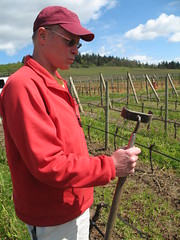 From just about anywhere in the Dundee Hills of the Willamette Valley, you can see a vineyard that depends on Allen Holstein's care. The wineries that source from them include some pretty big names in Willamette---Stoller, Domaine Drouhin, Argyle. Most of the 450 some-odd acres he maintains are Pinot Noir and various clones of Chardonnay, both of which adore the cool climate and sun. Even Allen's house atop a hill is surrounded by his own personal vineyard, one from which he once made his own label. He seemed skeptical about whether he'll ever make his own label again. He's more comfortable with his hands in the dirt than with gladhanding marketers and buyers.
From just about anywhere in the Dundee Hills of the Willamette Valley, you can see a vineyard that depends on Allen Holstein's care. The wineries that source from them include some pretty big names in Willamette---Stoller, Domaine Drouhin, Argyle. Most of the 450 some-odd acres he maintains are Pinot Noir and various clones of Chardonnay, both of which adore the cool climate and sun. Even Allen's house atop a hill is surrounded by his own personal vineyard, one from which he once made his own label. He seemed skeptical about whether he'll ever make his own label again. He's more comfortable with his hands in the dirt than with gladhanding marketers and buyers.Allen invited me to join him on his vineyard rounds. I climbed into his truck at the Argyle tasting room, stuck my digital voice recorder back in my bag, and pulled out a pen, meaning to take notes instead. This proved impossible, both because of the sheer density of his knowledge and the fact that it was so freaking GOR-geous outside that pointing my eyes downward was out of the question. The Willamette Valley ('Willamette' rhymes with 'Dammit', dammit) is as idyllic and visually stunning an agricultural area as you can imagine. Do not go there if you're allergic to the color green. Besides grapes which are relatively recent, the hills and valley floors are fat with apple trees, nut trees, Christmas pines, blueberries, grass seed fields and enormous commercial nurseries.
Allen believes that his formal education--a Masters of Horticulture from the University of Kentucky--is an indispensable tool for problem solving in the vineyards he manages. As we bump along on a dirt road that runs around a vineyard, he tells me about a mysterious ailment that's screwing up a line of his vines.
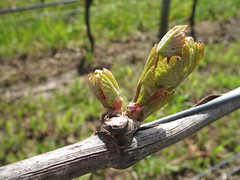 In an affected plant, the buds closest to the trunk of the vine suddenly looked burnt and withered, while the buds farther away seem fine. He's had experts from all over the world offer their theories, none of which have panned out. His own theory is controversial, and while he admits it has holes in it, reflects meticulous research, curiosity and expertise. Although I don't know squat about the inner workings of a vine's system, I find myself able to picture clearly why he's arrived at his conclusions. It occurs to me that he's probably the guy whose discoveries will make a big difference in the practices of viniculture in the Willamette. Just a hunch.
In an affected plant, the buds closest to the trunk of the vine suddenly looked burnt and withered, while the buds farther away seem fine. He's had experts from all over the world offer their theories, none of which have panned out. His own theory is controversial, and while he admits it has holes in it, reflects meticulous research, curiosity and expertise. Although I don't know squat about the inner workings of a vine's system, I find myself able to picture clearly why he's arrived at his conclusions. It occurs to me that he's probably the guy whose discoveries will make a big difference in the practices of viniculture in the Willamette. Just a hunch.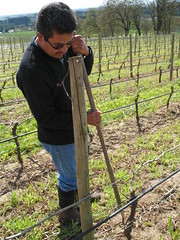
There's something big going on in each vineyard. At Knudsen, a man on a John Deere rips out an acre of vines that are to be replaced with new, better clones. At the Lone Star vineyard, Allen and a team from the University of Oregon are conducting experiments with the effect of different methods of ground cover cultivation (i.e. the "grass" between the rows of vines) on the vine's productivity. I hang back and watch as he pulls out a tape measure to take the width of a strip of green, then give directions in fluent Spanish to his vineyard manager. He's in touch with every last detail of these properties, but also knows how to trust the managers of each.
I asked him about the newly appointed Dundee Hills AVA, and it led to a discussion of all things area-designate: appellations, soil, vineyards, organics, the big terroir question.
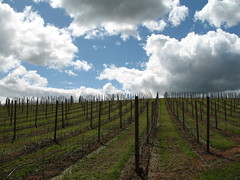
Allen's skeptical about all this stuff. Even as he knows very well how the elements of climate and soil play into fruit quality, he thinks the whole appellation thing is a big line of marketing talk. "There's enough problems getting people to recognize Oregon as a wine producer, why make it more difficult?" Likewise organics: Allen expressed his concern that the marketing bonus on the label wasn't worth the trouble and expense. For him, growing grapes is about well thought out choices--location, clone selection, property management. He sites several situations where claims of the impact made by certain chemicals on the soil turned out to be false. Regardless of my own opinion on the subjects, I realize this is a man with a great deal of experience who obviously isn't tossing deadly chemicals around willy nilly, but with thought, planning, and respect for the land. Watching him in action all day was fascinating.
*********
After talking to Allen Holstein, I tasted through the line of Argyle wines at the tasting room in Dundee. The Pinots are forward, have good balance, but are a little oaky for me. Now the sparklers...those are worth writing home about. I really dug the 1998 Knudsen Vineyard Brut (70% Pinot, 30% Chard), thought it was a fine, complex bottle o' bubbles for the money.
I was hungry after all that flawless scenery, and so I walked across the street to the Ponzi tasting room and Bistro. That's up next.
Clinkies, y'all.
I was hungry after all that flawless scenery, and so I walked across the street to the Ponzi tasting room and Bistro. That's up next.
Clinkies, y'all.

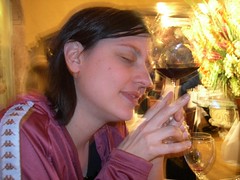



4 Comments:
I just discovered your blog and am having a great time reading it. You are getting close to my home country now as my grandparents on both sides of the family were farmers in the Yakima valley.
Speaking of how beautiful the Willamette Valley is, if you really want to see some scenery, make sure you head over to Eastern Washington wine country on the Washington side of the Columbia (highway 14) instead of I-84 on the Oregon side.
Have a great finish to your trip and thanks for sharing your adventures.
Thanks for reading! Part of the fun of discovery--a large part for me--is sharing it.
I *have* been to the Washington side of the Columbia, and you're right, it's absolutely stunning. Good mineral baths, too.
Cheers!
I've been looking forward to reading about your experiences in the Willamette Valley. Oregon is so gorgeous and the pinots are delicious. There is (or was, about four years ago) a great restaurant in Dundee called something like Red Hills Provincial Dining (I probably got that all wrong, but maybe close enough for you to know what I'm talking about) in an old arts and crafts-style house. I enjoyed your post on the other blog--brought back my own memories of the coast and tidepools.
P.S. Go have lunch at Higgins, then walk over to the art museum, then wander around the park out in front after you come out of the museum. You get extra I-Love-Portland points (or Portland does, I guess) if it's a farmers' market day.
Post a Comment
<< Home